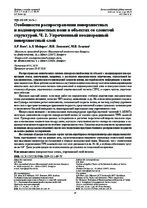Особенности распространения поверхностных и подповерхностных волн в объектах со слоистой структурой. Ч. 2. Упрочненный неоднородный поверхностный слой

Date
2019Publisher
Another Title
Features of the Surface and Subsurface Waves Application for Ultrasonic Evaluation of Physicomechanical Properties of Solids. Part 2. Strenghtned Inhomogeneous Surface Layer
Bibliographic entry
Особенности распространения поверхностных и подповерхностных волн в объектах со слоистой структурой. Ч. 2. Упрочненный неоднородный поверхностный слой = Features of the Surface and Subsurface Waves Application for Ultrasonic Evaluation of Physicomechanical Properties of Solids. Part 2. Strenghtned Inhomogeneous Surface Layer / А. Р. Баев [и др.] // Приборы и методы измерений : научно-технический журнал. – 2019. – Т. 10, № 1. – С. 69-79.
Abstract
Распространение импульсного сигнала поверхностной волны по объекту с неоднородным поверхностным слоем, полученным, например, в результате поверхностного упрочнения, структурной поврежденностью, сопровождается дисперсией скорости волны, несущей важную информацию о параметрах такого слоя. Цель работы заключалась в изучении взаимосвязи между акустическими параметрами импульсного акустического сигнала поверхностной и подповерхностной волн и поверхностного слоя стальных образцов, упрочненных закалкой токами высокой частоты (ТВЧ), и серого чугуна, упрочненного отбелом. Проведен краткий анализ известных работ по определению глубины упрочненных поверхностных слоев различными методами, включая ТВЧ закалку, цементацию и др. На основе интегрального выражения Оулдера. выполнен расчет зависимости, связывающей скорость волны, ее частоту, глубину упрочненного слоя и пространственное распределения твердости, представляемой в виде ступеньки с изменяющимся наклоном ее боковой поверхности, моделирующей переходную зону упрочненного слоя. Импульсным методом с использованием малоапертурных преобразователей частотой 1–3,8 МГц получены зависимости скорости поверхностной волны от высоты среза упрочненного ТВЧ закалкой слоя. Проведенное сравнение данных эксперимента и расчетов теоретической модели показало хорошее качественное соответствие между ними, высокую «чувствительность» метода по отношению к характеру изменения твердости по глубине упрочненного слоя. Показана перспективность предложенного подхода для решения обратной задачи восстановления пространственного распределения твердости на основе данных эксперимента. На стальных образцах и образцах серого чугуна апробирован метод гониометра для определения глубины упрочненного слоя по данным угла, соответствующего минимуму амплитуды отраженной волны или максимуму амплитуды возбуждаемой в образце поверхностной моды. Показано, что с увеличением толщины упрочненного ТВЧ закалкой слоя этот угол уменьшается на 24–26', а глубина отбеленного чугуна на ≈ 6°. Даны рекомендации по использованию результатов исследований на практике.
Abstract in another language
The propagation of a pulsed signal of a surface wave over an object with a non-uniform surface layer, obtained, for example, as a result of surface hardening, with structural damage, is accompanied by the dispersion of the velocity of the wave carrying important information about the parameters of such a layer. The aim of the work is to study the relationship between the acoustic parameters of a pulsed acoustic signal of a surface and subsurface waves and the surface layer of steel specimens hardened by high-frequency hardening, and gray iron-chill. Features of the surface and subsurface waves application for ultrasonic evaluation of physicomechanical properties of solids. Strenghtned inhomogeneous surface layer. A brief analysis of the known works on determining the depth of hardened surface layers by various methods, including high-frequency hardening, cementation, etc., is carried out. Based on the Oulder integral
expression. The dependence connecting the wave velocity, its frequency, the depth of the hardened layer and the spatial distribution of hardness represented as a step with a changing slope of its side surface simulating the transition zone of the hardened layer are calculated. Using the pulse method and low-aperture transducers with a frequency of 1−3.8 MHz, the dependences of the surface wave velocity on the cutting height of a layer hardened by HDTV hardening are obtained.
A comparison of experimental data and calculations of the theoretical model showed a good qualitative correspondence between them, demonstrate a high «sensitivity» of the method in relation to the nature of the change in hardness over the depth of the hardened layer. It is shown that the proposed approach is promising for solving the inverse problem of restoring the spatial distribution of hardness based on experimental data. The goniometric method was approbated to determine the dependence between amplitude-angle characteristics and depth of the surface steel layers hardened by high-frequency hardening and depth of hardened gray iron specimens layer – with chill. It is shown that the optimal angle corresponding maximum of excited surface wave amplitude in steel specimens is decreasing up to 24–26' vs. hardened depth layer. But when the tested specimens from cast iron this angle decreasing is nearly of 6°. Recommendations on the use of research results in practice are given.
View/Open
Collections
- Т. 10, № 1[11]
